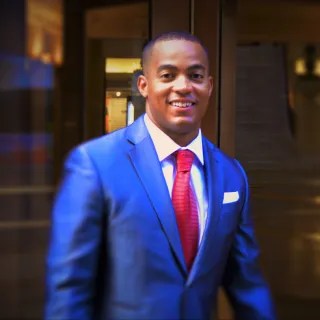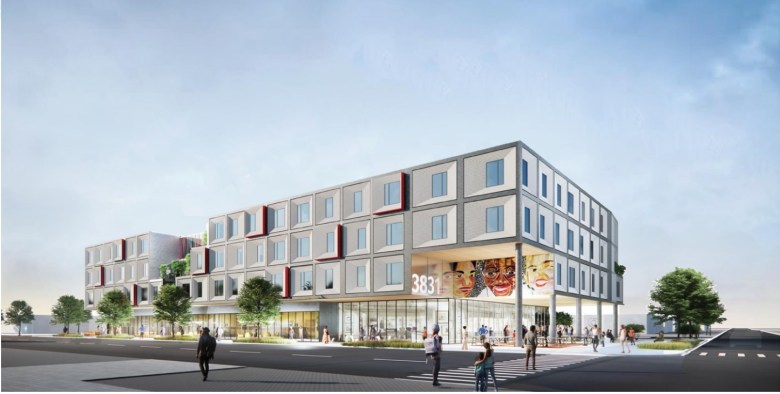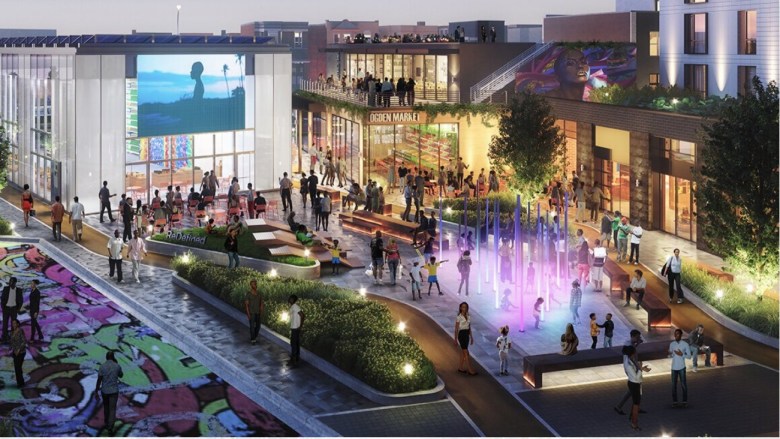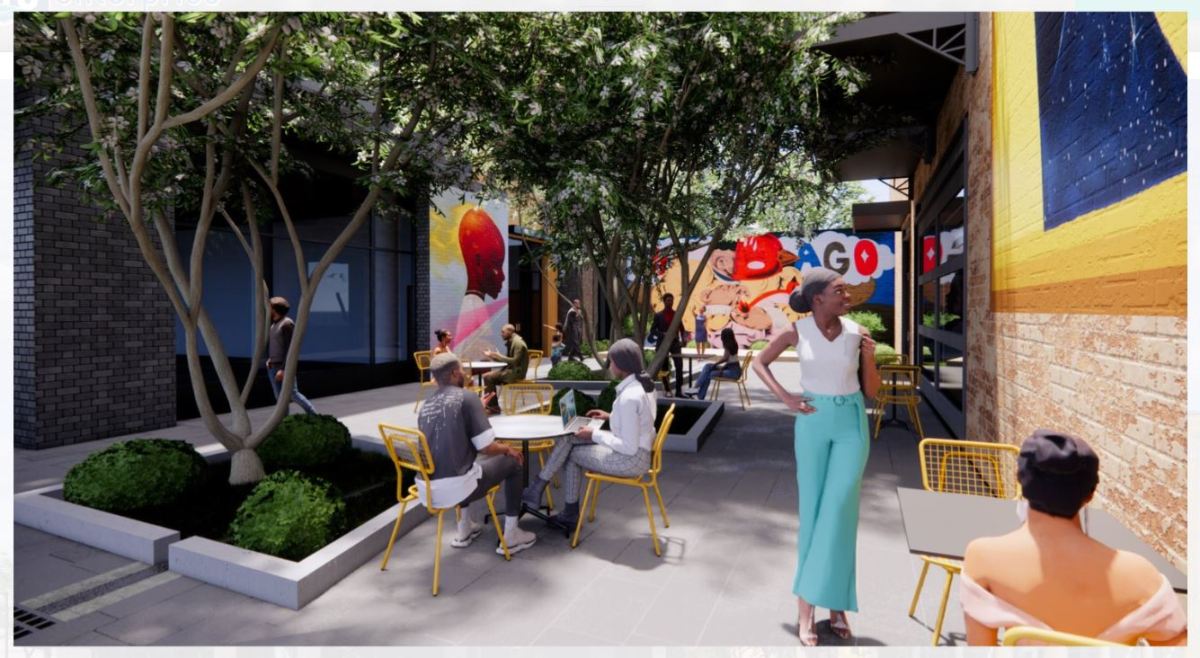Growing up in Terre Haute, Indiana, Robert “A.J.” Patton lived in a public housing complex. When he was a teenager, the gas was shut off in his family’s apartment — unit 548 — after his mother received a $400 bill she was unable to pay on her $10 hourly salary. He was forced to boil water on the family’s electric stove to bathe for more than a year. That experience remained with him into adulthood and inspired the name of his company.

Today his Chicago-based company, 548 Enterprise, is driven by a mission to provide clean energy developments and affordable housing to traditionally disinvested and low-income communities, using the services of BIPOC and woman-owned companies whenever possible.
“I’m starting to get more comfortable with sharing the origin story,” Patton said. “I historically am a relatively private person, so I don’t usually just throw my private stuff public. But I think it’s important to understand where inspiration is drawn from.”
Rather than hardening his outlook into cynicism, the hardships of his youth have inspired Patton to be intentional in leveraging the services of companies traditionally overlooked in the green energy space, despite facing skepticism from traditional lenders.
“The moment you raise your hand and say, ‘I’m going to need capital from the marketplace’ — the headwinds start there,” Patton said. “And then to have the audacity to say, ‘Not only am I going to raise capital, which is already difficult, but then we’re going to put that capital in low- and moderate-income communities, and we’re going to be intentional about using that capital for sustainable technologies.’ … And so now I really kind of put myself in a position. It took me two years to raise just a little bit of capital. The banks essentially shunned us. They said ‘No thank you’ for probably two years. And that was very, very difficult.”
Public health and equity
This approach has manifested in the development of Galleria 89, an energy-efficient affordable housing complex on the city’s South Side. Solar panels integrated with the building’s power system help further reduce the project’s climate impact.
Galleria 89 was the winning entry for the South Chicago community in Mayor Lori Lightfoot’s signature Invest South/West initiative — intended to revitalize disinvested neighborhoods on the city’s South and West sides.
Originally budgeted for $23.5 million, the project now carries an estimated price tag of $36.4 million, with a construction schedule still under development.
Designed as a mixed-use venture, 100% of its 58 residential units will be designated for households with incomes that fall below 60% of the area’s median income. The energy efficiency features of the complex will yield an average of 40% savings on monthly utility bills. All-electric heating, cooling and appliances will improve indoor air quality, according to Doug Farr, founder and principal of Farr Associates.
“We know there’s high rates of asthma in lower-income communities. A lot of it is due to cooking gas and the pollutants put in the living space due to that. So, by going all electric, we’re hoping to really knock down asthma rates for folks” living in the development, Farr said during an October 2022 presentation at PhiusCon 2022 in Chicago.
The coalition of contractors for Galleria 89 includes an assortment of firms owned largely by women and Black, Indigenous, and people of color: Patton is partnering with woman-owned Syzygy Cities to oversee development. Chicago-based firms Farr Associates; minority and LGBT+-owned Rivetna Architects; and Omni Ecosystems, headed by founder and CEO Molly Meyer, have been tasked with design. A pair of Chicago-based nonprofits, SkyArt and Pilsen Wellness Center, are acting as community partners. Gold Leaf Capital Partners, a Black-owned firm, is acting as a financial consultant.
Engineering for the project is being provided by three Black-owned Chicago-based firms: Milhouse Engineering, Engage Civil Incorporated, and Powers & Sons Engineering.

Patton expressed disdain that even established companies had been overlooked in the past.
“What’s funny is they’ve been sitting there in broad daylight this entire time,” he said. “And frankly, it’s an embarrassment that they’ve been there this whole time. There are capable and scalable African American-owned engineering firms that consistently are passed over for sustainable projects.”
In addition to providing much-needed affordable housing for South Chicago, Galleria 89 is designed to provide an engine for sustainable economic development. The complex will ultimately incorporate small businesses run by residents of the community, along with anchor commercial tenants, providing an opportunity for local entrepreneurs, Patton said.
“We met with business leaders probably three or four times to understand and hear them on what they wanted in terms of affordability, also what they wanted [for commercial elements], because there’s a retail component,” Patton said. “They made it clear that there were some retail ideas they wanted us to at least indulge and to see if we could make come to life.”
Energy efficiency and sustainability
Galleria 89 combines a smaller existing structure with larger new construction. The existing three-story brick building will undergo a complete retrofit, with 12 one-bedroom apartments and retail on the ground floor. The new five-story construction will also include retail at ground level along with 46 total units: 23 one-bedroom, 19 two-bedroom, and four three-bedroom layouts.
The new construction for Galleria 89 includes a number of energy efficiency features: optimized windows, thermally broken balconies, R-25 effective wall insulation and rooftop solar panels — all in a bid to meet stringent passive house [Phius] certification, which would make it the largest passive house structure in the city. Achieving Phius compliance required extensive revisions to the exterior of the building, Farr said.
“We [redesigned the original] massing which was very sculptural,” Farr said. “It was not Phius-friendly at all. It had more corners and insets and things that didn’t stack, dozens and dozens of small flying buttresses. It had kind of everything you don’t do in Phius. And so, we introduced some rationality to the massing, which really involved the fundamentals of stacking things and having much more predictable and regular and fewer insets and so on.”
With Galleria 89, 548 Enterprise is going above and beyond Phius requirements to further reduce operating costs, Farr said.
The Illinois Solar For All program requires that half of the savings generated by energy created by the building’s rooftop solar panels must be passed through to tenants, Farr said.
The inclusion of solar panels especially was a nonnegotiable for Patton.
“We’re going all in on solar for affordable housing and making it accessible for all. And that’s what we’re going to do, full stop,” Patton said.
Galleria 89 is not the only sustainable community project Patton is involved with.
548 Enterprise is also overseeing the development of Humboldt Park Passive Living — another Invest South/West project projected for completion in summer 2024. This mixed-use new construction includes approximately 60 mixed-income residential units along with commercial and community space. Also featuring rooftop solar, the project is estimated to provide between 33% and 50% utility savings for residents and commercial tenants.


An acre of vacant land in North Lawndale on the city’s West Side is the site for Lawndale ReDefined — a $31.4 million Invest South/West project scheduled to begin construction in the first quarter of 2023. GRE Ventures, a collaboration between 548 Enterprises, GMA Construction Group and Imagine Development Group — all Black-owned — is developing the project.
Centered around a human-scale plaza called The Square, Lawndale ReDefined is a mixed-use project that includes 60 affordable and market-rate rental units along with three townhomes for sale. Other features include a walking trail and wellness center. The Cube, an arts and technology center operated by City Colleges of Chicago, will provide community meeting space and job training.
Addressing the bottom line
Financing for Galleria 89 is being drawn from multiple sources, including low-income housing tax credits and resources stemming from the Inflation Reduction Act. State-level financial support for solar energy installations for affordable housing has also been instrumental, as has tax increment financing through the Invest South/West program.
Cross-referencing construction costs with energy efficiency goals also works to bridge the gap between sustainability and financial viability for affordable housing projects. In many cases, energy efficiency savings can significantly reduce or offset higher upfront costs, Patton said.
“People just assume that sustainable is more expensive without even doing the research or talking to the construction community,” he said. “It may just be different, not more expensive. … For example, we have buildings that we’re installing solar on that will create $40,000 a year in savings [in electricity costs]. If I could save you $40,000 a year, I have your attention, right? That’s a lot of money. That’s a staff person.
“And then you extrapolate that out over several years, you’re going to save hundreds of thousands of dollars by that commitment of renewable energy. If you paired that with efficient HVAC and lighting systems, high efficiency windows — now we’re getting closer and closer to almost six figures a year in energy savings, real savings, real dollars. If everything else kind of historically pays for itself somewhere between six and six and a half years; if I plan on holding this property for any significant period of time, I’m in the black real quickly.”
Correction: This article was updated to correct a quote from A.J. Patton. He said, “We’re going all in on solar for affordable housing and making it accessible for all. And that’s what we’re going to do, full stop.”

